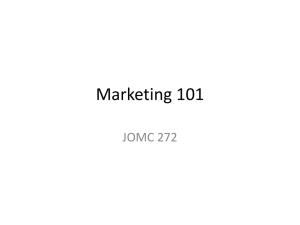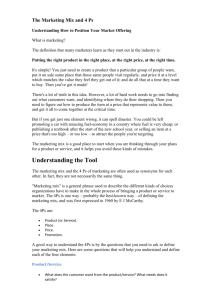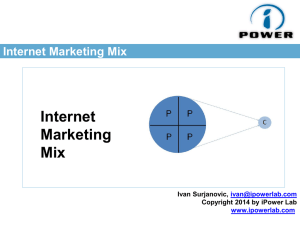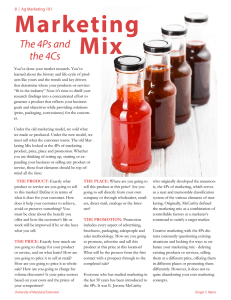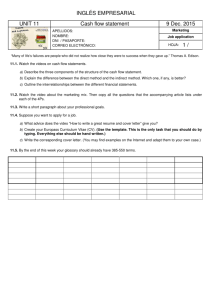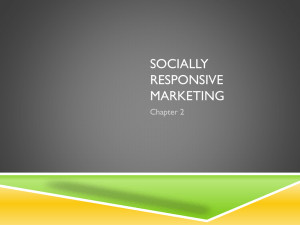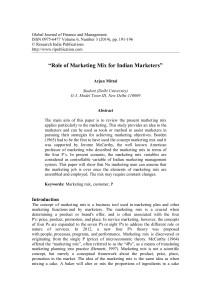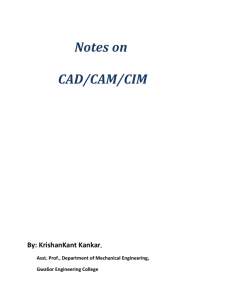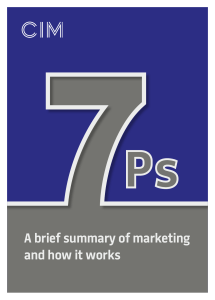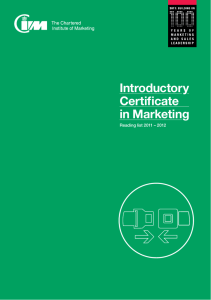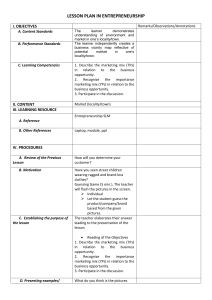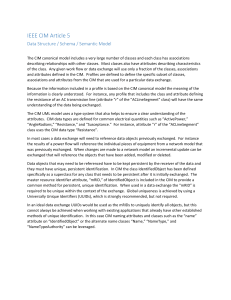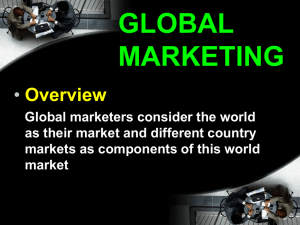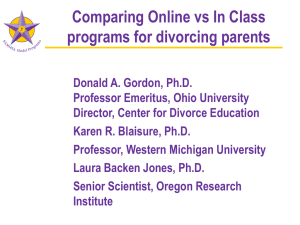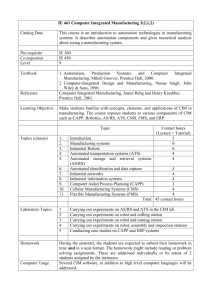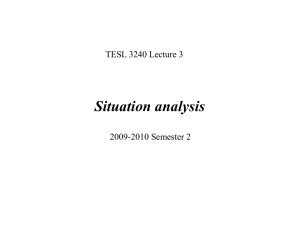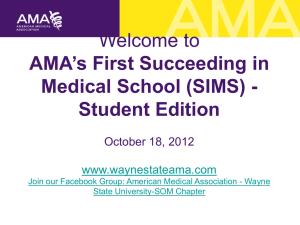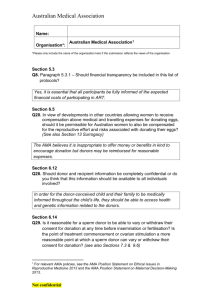Marketing
advertisement
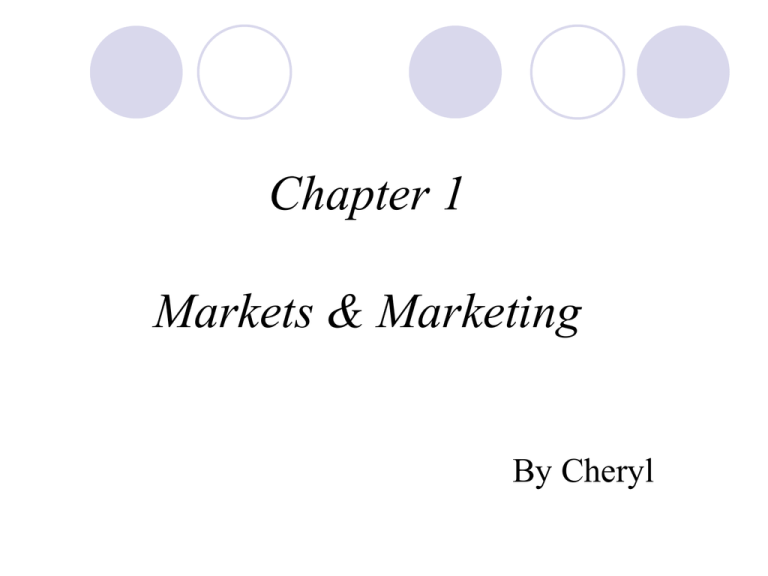
Chapter 1 Markets & Marketing By Cheryl The main contents 主要内容 The history of marketing 营销的历史 Definitions of marketing 营销的定义 Marketing concepts 营销观念 The marketing mix 营销组合 Marketing management 营销管理 1.The history of marketing 营销的历史 营销是如何出现的??? Bartering A fledged market Production orientation Mass Marketing Figure 1.1 The history of markets 1.1 Bartering 物物交换 1.2 Exchanged by money: a fledged market 一个成熟的市场 1.3 Production orientation: mass production 生产集中化-批量生产-降低成本 注重于生产与销售,而不是市场营销 出现供过于求的现象 supply excess demand 如何平衡供求?--marketing techniques was developed. 2. Definitions of marketing 营销定义 2.1 “Marketing is the management process which identifies, anticipates and supplies customer requirements efficiently and profitably.” (CIM, 2001) 营销是识别,预见以及有效地和有利地满 足顾客需求的管理过程。 1.4 Mass marketing techniques 大规模营销技巧首先被运用于快速消 费品上。(fast-moving consumer goods) 随后被应用于工业产品及服务上。 2.3 “Marketing is the process of planning and executing the conception, pricing, promotion, and distribution of ideas, goods, and services to create exchanges that satisfy individual and organizational goals.” (AMA,1985) 2.2 “Marketing is concerned with meeting business objectives by providing customer satisfactions.” 营销通过提供顾客满意来达成企业的 目标. A kind of solution 市场营销是计划和执行关于创意、商品、 和服务的概念、定价、促销和分销,以 创造满足个人和组织目标的交换的一种 过程。 Activity one P9 When people surfing kaixin001.com or xiaonei.com, what problems are they trying to solve? 3.Marketing concepts 营销观念 3.1 Definition: “ the attitude that business decisions should be based on what the consumer wants.” 营销观念是一种商业决策应基于消费者 需要的态度。 To identify the consumer wants 确定消费者的 需要 To satisfy the wants of consumers 满足消费者 的需要 To make a profit 并且获取利润 Discussion P9 Do u think telephone companies have followed the marketing concept as regards telephone boxes? Implications for business 对企业的应用 a) b) c) A organisation needs: Doing marketing researching A spirit of innovation A good ability of managing its marketing activities 3.2 A summary of marketing history and business orientation (Table 1.1) Starting point Production Factory Product Sales orientation Marketing orientation Focus Means End Manufacturin g •Increase production •Cost reduction and control Make profit through volume Make profit through volume Factory Goods •Quality is all that matters •Improve quality levels Factory Existing Products •Selling + Promoting Profit through sales volume Market Customer Needs •Integrated marketing Profit through customer satisfaction Production orientation 生产导向 (19世 纪末20世纪初) Product orientation 产品导向 (19世纪末 20世纪初) Sales orientation 销售导向 (20世 纪50年代到60年代) Marketing orientation (customer orientation) 市场导向 (20世纪60至 70年代 ) Think!!! 麦当劳,肯德基提供的快餐,虽然味道不错 但是缺乏营养.他们在满足顾客的需求的同 时也可能会对顾客的健康造成损害.再则,快 餐行业所使用的一次性饭盒,虽然方便了顾 客,但却对环境造成了影响. 这个现象说明了现代营销观念的什么问题? Societal and Ethical marketing 社会与 生态市场营销(20世纪70年代) 3.3 Elements of the marketing concept 营销观念的组成部分 Customer orientation 顾客导向 Co-ordination of market led activities 以 市场为导向的各项活动的协调 Profit orientation 利润导向 4. Marketing and the business system The distribution system The information system The flow of influence: (PEST) 环境影响 因素 4. Marketing issues 4.1 Product differentiation 产品差异化 “ Product differentiation occurs when specific products or brands each have a specific combination of costs and benefits which a particular set of potential customers seek.” Features, e.g. General Motors (Onstar定位 系统) Style, e.g. Starbucks Reparability, e.g. Cisco 思科 (网上常见 问题知识库) Quality…… 4.2 Contact and distribution 沟通与分销 “ Contact is ensuring that the customers know about a product or service.”--communication 沟通就是确保顾客了解一个产品或服务. Cont. “ Distribution is ensuring that products or services are made accessible and available to consumers or buyers.” 确保产品或服务对消费者或购买者来说是 容易获得的. 4.3 Marketing in business 商业中的营销 “ Marketing is the performance of business activities that direct the flow of goods and services from organizations to their customers.” 营销就是引导产品和服务从组织流向顾客 的商业活动的表现. “ Marketing involves the business understanding the needs and wants of customers and adapting the operations to deliver the right goods and services more efficiently and effectively than its competitors.” 营销包括企业对顾客需要和需求的了 解,并采取适当的措施比竞争对手更 有效率地和更有效地传送产品和服务。 4.4 Needs and profits 需要和利润 “ Marketing is concerned with the matching of an organization’s capabilities with consumers’ wants.” 营销关注的是组织能力与消费者需求的 匹配。 “Marketing is the process of determining consumer demand for a product motivating its sale and distributing it into ultimate consumption at a profit.” 营销是决定消费者对某一产品的需求,刺 激它的销售并且在获利基础上分销到终端 消费的一个过程。 Activity P18 5.The marketing mix 5.1 The marketing mix: 4Ps and 7Ps “Marketing is the ability of an organization to provide the right product, at the right price, via the right outlets (place) and presented in the right way (promotion).” (BPP,2004) • a) b) c) 4Ps: product, place, price and promotion Product The physical aspect The functional aspect The symbolic aspect Different levels of product The augmented product Actual product The core product •The most basic description •Physical features •Extra benefits Figure 1.3 levels of product • Price Fixed costs Costs Variable costs Considerations for pricing Competitors’ prices Consumers’ perceptions • Place a) Distribution channels b) Middlemen Wholesalers Merchants Retailers Agents and brokers • The promotion mix Advertisement Sales promotion Personal selling The promotion mix Direct marketing PR Figure 1.4 the promotion mix The three Cs or strategic triangle 战略三角 ( Kenichi Ohmae, 1983) • The company itself 公司 • The customer 顾客 • The competition 竞争对手 7Ps “ A service is any activity or benefit offered by one party to another which is essentially intangible and does not result in the ownership of anything physical.” (BPP,2004) • Characteristics of service a)Intangibility b)Variability c)Inseparability d)Lack of ownership : 4Ps+process, physical evidence and people (Booms and Bitner, 1981) • Process: services are manufactured and consumed live---how is the service delivered? • Physical evidence: atmosphere, image and design of premises • People: to perform services and then add value to the marketing package way Activity Service industry: travel agents…P27 People ? Process ? Physical evidence ? 6.Marketing management 6.1 Definition: “Marketing management is the process of devising, implementing and monitoring the marketing plan.” 营销管理是作出,执行和控制营销计划的 过程。 6.2 Analysis, Planning and Control 分析,计划 与控制 Quantitative analysis 量的分析 Analysis Information The strategic marketing Plan Qualitative analysis 质的分析 Planning 战略性的市场计划 Performance against targets 成果相对于目标 Control Remedial action Figure 1.5 The marketing plan 4.3 The marketing department Sales The sales department Marketing Development The sales department The marketing department Figure 1.6 the development of marketing department 4.4 Relationship with other departments Marketing Finance Finance Marketing Production Human Resources Human resources Production a. Marketing as an equal function b. Marketing as the dominant function Finance Marketing Human resources Human resources Finance customer Production Production c. Marketing as the integrative function Marketing d. Marketing dominates/integrates but customer controls 6.Marketing & Society 6.1 Definition: “The societal marketing concept is a …….” (P30) “ Social responsibility is accepting responsibilities to the various publics of an organization which go beyond contractual or legal requirements.” 6.2 Social responsibility Responsibility to customers • To offer a quality product or service • Consumerism: “ it is a term used to describe the increased importance and power of consumers.” • Customer care---to bring long-term benefits. Responsibility to the community • Supportive • Contributive • Responding Responsibility to employees • Working environment • Training and development schemes • Redundancy and retirement policies Responsibility to suppliers • Equality • Keep information in confidential Responsibility to competitors • Ethics • A number of law Summary Definitions of marketing (CIM&AMA) The history of marketing orientation: from production orientation to societal marketing orientation. Three main elements of marketing concept: customer orientation, co-ordination of market led activities and profit orientation. The marketing mix Questions What is marketing? Please compare alternative definitions of marketing. What are the main elements of marketing concept? Key words Exchange 交换 Market 市场 Marketing 市场营销 Marketing concept 市场营销观念 Marketing orientation 营销导向 Cont. Production orientation 生产导向 Customer satisfaction 顾客满意 The marketing mix 营销组合 Promotion mix 促销组合 Place ( Distribution) 分销 Cont. Marketing management 营销管理 Consumer research 消费者调查 Quantitative analysis 量的分析 Qualitative analysis 质的分析 Target markets 目标市场 Cont. Social responsibility 社会责任 Consumerism 消费者主义 CIM: the UK’s Chartered Institute of Marketing 英国特许营销协会 AMA: the American Marketing Association 美国营销协会 Case study 美国皮尔斯堡面粉公司,于1869年成立,从成 立到20年代以前,这家公司提出“本公司旨在制 造面粉”的口号。因为在那个年代,人们的消费 水平很低,面粉公司无须太多宣传,只要保持面 粉质量,降低成本与售价,销量就会大增,利润 也会增加,而不必研究市场需求持点和推销方法。 1930年左右,美国庆尔斯堡公司发现,竞争加 剧,销量开始下降。公司为扭转这一局面,第一 次在公司内部成立商情调研部门,并选派大量推 销员,扩大销售量,同时把口号变为“本公司旨 在推销面粉”, 更加注意推销技巧,进行大量广告宣传,甚至开 始硬性兜售。然而随着人们生活水平的提高,各 种强力推销未能满足顾客变化的新需求,这迫使 面粉公司从满足顾客心理相实际需求的角度出发, 对市场进行分析研究。1950年前后公司根据战后 美国人的生活需要开始生产和推销各种成品和半 成品的食品,使销量迅速上升。 1958年后,公 司着眼于长期占领市场,着重研究今后3年到30 年的市场消费趋势,不断设计和制造新产品,培 训新的推销人员。 Questions !!! 请分析是什么原因促使皮尔斯堡公司的营 销发生转变? 请根据这一转变,说明市场营销观念的转 变和各阶段的特点。
